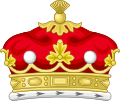| Baronet of Haddo, 1642 | |
John Gordon
1610–1644
1st Baronet, of Haddo | |
| Baronetcy forfeited, 1644 | |
| | | | | | | | | | | | | | | Baronetcy restored, 1660 | | Earl of Aberdeen, Viscount of Formartine, and Lord Haddo, Methlic, Tarves and Kellie, 1682 | |
John Gordon
c. 1632–1665
2nd Baronet, of Haddo | | George Gordon
1637–1720
1st Earl of Aberdeen, Viscount of Formartine, and Lord Haddo, Methlic, Tarves and Kellie
3rd Baronet, of Haddo | |
| | | | | | | | |
| | | | William Gordon
1679–1746
2nd Earl of Aberdeen, Viscount of Formartine, and Lord Haddo, Methlic, Tarves and Kellie
4th Baronet, of Haddo | |
| | | | | | | | |
| | | | George Gordon
1722–1801
3rd Earl of Aberdeen, Viscount of Formartine, and Lord Haddo, Methlic, Tarves and Kellie
5th Baronet, of Haddo | |
| | | | | | | | |
| | | | George Gordon
1764–1791
| |
| | | | | | | | |
| | | | Viscount Gordon, 1814 | |
| | | | George Hamilton-Gordon
1784–1860
4th Earl of Aberdeen, Viscount of Formartine, and Lord Haddo, Methlic, Tarves and Kellie
1st Viscount Gordon
6th Baronet, of Haddo | |
| | | | | | | | |
| | | | George John James Hamilton-Gordon
1816–1864
5th Earl of Aberdeen, Viscount of Formartine, and Lord Haddo, Methlic, Tarves and Kellie
2nd Viscount Gordon
7th Baronet, of Haddo | |
| | | | | | | | | | | | | | | | | | | | | | | | | | | Marquess of Aberdeen and Temair and Earl of Haddo, 1916 | |
| | | | George Hamilton-Gordon
1841–1870
6th Earl of Aberdeen, Viscount of Formartine, and Lord Haddo, Methlic, Tarves and Kellie
3rd Viscount Gordon
8th Baronet, of Haddo | | John Campbell Hamilton-Gordon
1847–1934
1st Marquess of Aberdeen and Temair and Earl of Haddo
7th Earl of Aberdeen, Viscount of Formartine, and Lord Haddo, Methlic, Tarves and Kellie
4th Viscount Gordon
9th Baronet, of Haddo | |
| | | | | | | | | | | | | | | | | | | | | | | | | | | | | | George Gordon
1879–1965
2nd Marquess of Aberdeen and Temair and Earl of Haddo
8th Earl of Aberdeen, Viscount of Formartine, and Lord Haddo, Methlic, Tarves and Kellie
5th Viscount Gordon
10th Baronet, of Haddo | | Dudley Gladstone Gordon
1883–1972
3rd Marquess of Aberdeen and Temair and Earl of Haddo
9th Earl of Aberdeen, Viscount of Formartine, and Lord Haddo, Methlic, Tarves and Kellie
6th Viscount Gordon
11th Baronet, of Haddo | |
| | | | | | | | | | | | | | | | | | | | | | | | | | | | | | | | | | | | | | | | | | | | | | | David George Ian Alexander Gordon
1908–1974
4th Marquess of Aberdeen and Temair and Earl of Haddo
10th Earl of Aberdeen, Viscount of Formartine, and Lord Haddo, Methlic, Tarves and Kellie
7th Viscount Gordon
12th Baronet, of Haddo | | Archibald Victor Dudley Gordon
1913–1984
5th Marquess of Aberdeen and Temair and Earl of Haddo
11th Earl of Aberdeen, Viscount of Formartine, and Lord Haddo, Methlic, Tarves and Kellie
8th Viscount Gordon
13th Baronet, of Haddo | | Alastair Ninian John Gordon
1920–2002
6th Marquess of Aberdeen and Temair and Earl of Haddo
12th Earl of Aberdeen, Viscount of Formartine, and Lord Haddo, Methlic, Tarves and Kellie
9th Viscount Gordon
14th Baronet, of Haddo | |
| | | | | | | | | | | | | | | | | | | | | | | | |
| | | | | | | | | | | | | | | | | | | | Alexander George Gordon
1955–2020
7th Marquess of Aberdeen and Temair and Earl of Haddo
13th Earl of Aberdeen, Viscount of Formartine, and Lord Haddo, Methlic, Tarves and Kellie
10th Viscount Gordon
15th Baronet, of Haddo | |
| | | | | | | | | | | | | | | | | | | | | | | | |
| | | | | | | | | | | | | | | | | | | | George Ian Alastair Gordon
b. 1983
8th Marquess of Aberdeen and Temair and Earl of Haddo
14th Earl of Aberdeen, Viscount of Formartine, and Lord Haddo, Methlic, Tarves and Kellie
11th Viscount Gordon
16th Baronet, of Haddo | |
| | | | | | | | | | | | | | | | | | | | | | | | |
| | | | | | | | | | | | | | | | | | | | Ivo Alexander Ninian Gordon
b. 2012
styled Earl of Haddo | |
| | | | | | | | | | | | | | | | | | | | Heir apparent | |
|





